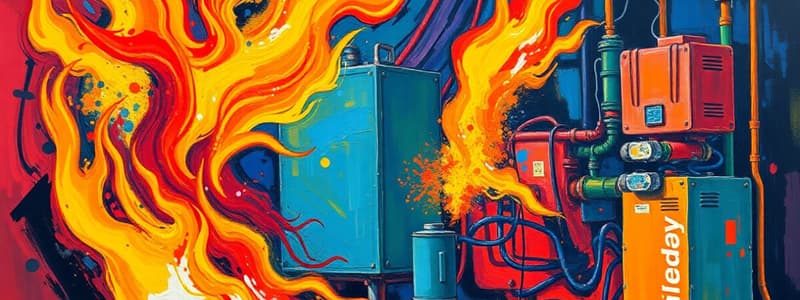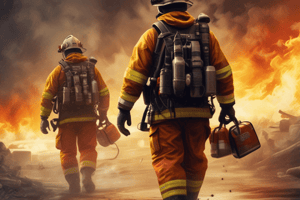Podcast
Questions and Answers
What are the main reasons why LIBs can rupture and disperse flammable gases or explode?
What are the main reasons why LIBs can rupture and disperse flammable gases or explode?
- Overheating, corrosion, improper storage, and faulty manufacturing.
- Mechanical stress, electrical short circuits, chemical instability, and prolonged charging.
- High voltage, chemical reactions, external heat sources, and accidental punctures.
- Thermal conditions, physical impact, electrical issues, and exposure to water. (correct)
What is the potential danger associated with LIBs in a fire?
What is the potential danger associated with LIBs in a fire?
- LIBs can release toxic fumes that can harm firefighters.
- LIBs can cause explosions that can spread the fire.
- LIBs can generate heat, intensifying the fire.
- All of the above. (correct)
Which of these actions is NOT recommended when dealing with a LIB that has been submerged in water?
Which of these actions is NOT recommended when dealing with a LIB that has been submerged in water?
- Dry the battery thoroughly before re-using it. (correct)
- Immediately discard the battery.
- Discard the battery immediately if the water was saltwater.
- Contact a professional for disposal if the battery is damaged.
What is a potential consequence of LIBs entering 'thermal runaway'?
What is a potential consequence of LIBs entering 'thermal runaway'?
Why is it important to be aware of the potential for re-ignition with LIBs?
Why is it important to be aware of the potential for re-ignition with LIBs?
What does the text recommend for staff handling LIBs that have been involved in a fire?
What does the text recommend for staff handling LIBs that have been involved in a fire?
What is the primary concern regarding LIBs being used in everyday applications?
What is the primary concern regarding LIBs being used in everyday applications?
Why does saltwater pose a greater danger to LIBs than freshwater?
Why does saltwater pose a greater danger to LIBs than freshwater?
What does the text suggest as a possible preventative measure for LIB fires?
What does the text suggest as a possible preventative measure for LIB fires?
What is the primary reason for the increase in fires involving LIBs?
What is the primary reason for the increase in fires involving LIBs?
Why might it be difficult to extinguish large fires involving LIBs?
Why might it be difficult to extinguish large fires involving LIBs?
Which of the following actions should be taken when responding to a fire involving LIBs?
Which of the following actions should be taken when responding to a fire involving LIBs?
What is the primary extinguishing agent for fires involving LIBs?
What is the primary extinguishing agent for fires involving LIBs?
What is the purpose of a 360° visual assessment during a fire involving LIBs?
What is the purpose of a 360° visual assessment during a fire involving LIBs?
What are the concerns for Incident Commanders when responding to EV fires?
What are the concerns for Incident Commanders when responding to EV fires?
What is the main consideration for Incident Commanders in deciding whether to implement a Defensive Operation for a fire involving LIBs?
What is the main consideration for Incident Commanders in deciding whether to implement a Defensive Operation for a fire involving LIBs?
Why is it important for crews responding to fires involving LIBs to be prepared for reignition or explosions?
Why is it important for crews responding to fires involving LIBs to be prepared for reignition or explosions?
What role does the Division Chief (DVC) Fire Investigations play in incidents involving LIBs?
What role does the Division Chief (DVC) Fire Investigations play in incidents involving LIBs?
What is the purpose of recording conversations during a fire involving LIBs?
What is the purpose of recording conversations during a fire involving LIBs?
What is the significance of the 360s visual assessment for photovoltaic solar panels?
What is the significance of the 360s visual assessment for photovoltaic solar panels?
What is the primary risk associated with lithium-ion batteries?
What is the primary risk associated with lithium-ion batteries?
Which of the following describes an Energy Storage System (ESS)?
Which of the following describes an Energy Storage System (ESS)?
Who is responsible for ensuring compliance with TFS guidelines during incident operations?
Who is responsible for ensuring compliance with TFS guidelines during incident operations?
Which of the following is NOT a type of Energy Storage System?
Which of the following is NOT a type of Energy Storage System?
Which of the following is included in the potential consequences of thermal runaway?
Which of the following is included in the potential consequences of thermal runaway?
What type of vehicle is classified as an Electric Vehicle (EV)?
What type of vehicle is classified as an Electric Vehicle (EV)?
What is a characteristic feature of lithium-ion batteries?
What is a characteristic feature of lithium-ion batteries?
What is one of the guidelines for firefighters when dealing with incidents involving lithium-ion batteries?
What is one of the guidelines for firefighters when dealing with incidents involving lithium-ion batteries?
What type of thermal runaway risk does lithium-ion battery present?
What type of thermal runaway risk does lithium-ion battery present?
How can the increased use of lithium-ion batteries affect fire services?
How can the increased use of lithium-ion batteries affect fire services?
What is the primary resource for information about Lithium-ion batteries (LIBs) according to the provided content?
What is the primary resource for information about Lithium-ion batteries (LIBs) according to the provided content?
Which safety precaution is emphasized for handling LIBs even after they are shut down or discharged?
Which safety precaution is emphasized for handling LIBs even after they are shut down or discharged?
What is the primary concern associated with LIBs in thermal runaway or off-gassing?
What is the primary concern associated with LIBs in thermal runaway or off-gassing?
Which of the following must be completed and announced to the Incident Commander as a benchmark during a LIB event?
Which of the following must be completed and announced to the Incident Commander as a benchmark during a LIB event?
What is the designated equipment to use when removing unaffected LIBs from the vicinity of a LIB event?
What is the designated equipment to use when removing unaffected LIBs from the vicinity of a LIB event?
Why should firefighters stay out of the vapor cloud created by LIBs in thermal runaway or off-gassing?
Why should firefighters stay out of the vapor cloud created by LIBs in thermal runaway or off-gassing?
What specific action should personnel take when LIB assemblies or ESS containers are involved in an event?
What specific action should personnel take when LIB assemblies or ESS containers are involved in an event?
Who is responsible for developing a plan to isolate or remove LIBs from an incident scene?
Who is responsible for developing a plan to isolate or remove LIBs from an incident scene?
What is the primary concern regarding EVs connected to a charging system during power loss or shutdown?
What is the primary concern regarding EVs connected to a charging system during power loss or shutdown?
Why might larger evacuation areas be necessary in high-rise buildings during a LIB event?
Why might larger evacuation areas be necessary in high-rise buildings during a LIB event?
Flashcards
What is an Energy Storage System (ESS)?
What is an Energy Storage System (ESS)?
A battery or group of batteries designed to store energy for later use.
How are ESS systems made?
How are ESS systems made?
These systems can be custom-made, off-the-shelf products, or even DIY creations.
What is a walk-in container ESS?
What is a walk-in container ESS?
A type of ESS that can be walked into, usually found outdoors.
What is an outdoor cabinet ESS?
What is an outdoor cabinet ESS?
Signup and view all the flashcards
What is an indoor facility ESS?
What is an indoor facility ESS?
Signup and view all the flashcards
What are vehicle batteries?
What are vehicle batteries?
Signup and view all the flashcards
What is an Electric Vehicle (EV)?
What is an Electric Vehicle (EV)?
Signup and view all the flashcards
What is Thermal Runaway?
What is Thermal Runaway?
Signup and view all the flashcards
What are the risks of Thermal Runaway?
What are the risks of Thermal Runaway?
Signup and view all the flashcards
Why are LIBs a concern for firefighters?
Why are LIBs a concern for firefighters?
Signup and view all the flashcards
Full PPE
Full PPE
Signup and view all the flashcards
SCBA
SCBA
Signup and view all the flashcards
LIB assemblies or ESS containers
LIB assemblies or ESS containers
Signup and view all the flashcards
Canutec
Canutec
Signup and view all the flashcards
Ejected cells
Ejected cells
Signup and view all the flashcards
Unaffected LIBs
Unaffected LIBs
Signup and view all the flashcards
Handling LIBs
Handling LIBs
Signup and view all the flashcards
Stranded Energy
Stranded Energy
Signup and view all the flashcards
Non-conductive equipment
Non-conductive equipment
Signup and view all the flashcards
EV charging systems
EV charging systems
Signup and view all the flashcards
LIBs and Fire Safety
LIBs and Fire Safety
Signup and view all the flashcards
LIBs: Hazards and Explosion
LIBs: Hazards and Explosion
Signup and view all the flashcards
LIBs: Thermal Runaway and Gas Release
LIBs: Thermal Runaway and Gas Release
Signup and view all the flashcards
LIBs: Re-Ignition Hazard
LIBs: Re-Ignition Hazard
Signup and view all the flashcards
Water and LIBs: Thermal Runaway
Water and LIBs: Thermal Runaway
Signup and view all the flashcards
Do not Open LIB Container
Do not Open LIB Container
Signup and view all the flashcards
LIBs: Discarding after Water Submersion
LIBs: Discarding after Water Submersion
Signup and view all the flashcards
LIBs and Gas Mixture
LIBs and Gas Mixture
Signup and view all the flashcards
Explosion Potential of LIBs
Explosion Potential of LIBs
Signup and view all the flashcards
White Smoke: Warning Sign of LIBs
White Smoke: Warning Sign of LIBs
Signup and view all the flashcards
How should the Incident Commander document a battery fire?
How should the Incident Commander document a battery fire?
Signup and view all the flashcards
Why might TICs be unreliable for battery fires?
Why might TICs be unreliable for battery fires?
Signup and view all the flashcards
What is the primary extinguishing agent for LIB fires?
What is the primary extinguishing agent for LIB fires?
Signup and view all the flashcards
What precautions should crews take during LIB fires?
What precautions should crews take during LIB fires?
Signup and view all the flashcards
When might a Defensive Operation be necessary at a LIB fire?
When might a Defensive Operation be necessary at a LIB fire?
Signup and view all the flashcards
Why are EV fires in garages especially dangerous?
Why are EV fires in garages especially dangerous?
Signup and view all the flashcards
Why is post-incident decontamination important after LIB fires?
Why is post-incident decontamination important after LIB fires?
Signup and view all the flashcards
Who decides if a fire watch is necessary after a battery fire?
Who decides if a fire watch is necessary after a battery fire?
Signup and view all the flashcards
Where should conversations about battery fires be recorded?
Where should conversations about battery fires be recorded?
Signup and view all the flashcards
Study Notes
Firefighting Operations Involving Lithium-Ion Batteries
- This guideline provides Toronto Fire Service (TFS) personnel with procedures for firefighting operations involving lithium-ion batteries (LIBs) in residential and commercial buildings.
- Incident conditions necessitate adapting actions to TFS guidelines, policies, and procedures.
Responsibilities
- All TFS personnel are responsible for safety and following established Standard Operating Guidelines (SOGs) during operations.
- TFS personnel must understand guidelines for responses to lithium-ion battery and ESS (Energy Storage Systems) emergencies.
- Company officers ensure all personnel follow established guidelines.
Definitions
- Energy Storage Systems (ESS): A battery system storing energy for later use. This can involve proprietary, aftermarket, or DIY battery systems. There are four types:
- Walk-in container system (outdoor)
- Outdoor cabinet (not walk-in)
- Indoor facility (residential, commercial, public utility)
- Large and small vehicle batteries
- Electric Vehicle (EV): A vehicle powered by a battery with an electric motor.
- Thermal Runaway: A phenomenon where a lithium-ion cell enters an uncontrollable, self-heating state with possible gas dispersion, shrapnel/particulates, or fire.
Background
- LIBs are increasingly used consumer products, from small devices to large-scale power grids.
- LIB fires are rising with resulting fatalities.
- LIB fire involvement can increase intensity even if unrelated to initial cause.
Hazards
- LIBs explode or violently rupture when exposed to extreme temperatures, impacted, crushed, pierced, electrical over-charging or forced discharge, or drying after being wet.
- LIBs release flammable, explosive, and toxic gases.
- Toxicity and flammability depend on battery technology and manufacturer. Pressurized gases may appear as white smoke.
Safety Considerations
- All TFS personnel working in controlled areas must wear full PPE (Protective Personal Equipment), SCBA, and face-piece.
- No LIB assemblies or ESS containers are to be opened or overhauled on safety grounds.
- Heavy Haz and Haz Support may be requested.
- Canutec (*666) should be consulted for on-site information. A search must be conducted for potentially ejected cells.
- Any unaffected LIBs must be removed.
- Do not introduce ignition sources or use conductive methods (using metal tools).
Incident Actions for Fires
- Water is the primary extinguishing agent, used as a cooling agent for exposed LIBs.
- 360-degree assessments should include photovoltaic solar panel and ESS unit visual checks.
- Large fires may require defensive operations with protection for exposures and personnel.
- Crews must use safety precautions, including non-conductive equipment.
- Water application may be needed long after flames are extinguished.
Electric Vehicle Fires
- EV fires in single-family garages need careful consideration due to backdraft or explosions.
- Garage doors may blow out unexpectedly, requiring alternative attack strategies—smaller entry doors may be a preferred approach.
- Avoid introducing ignition sources.
- EVs produce more smoke and gases than fuel-burning vehicles.
- Considerations for underground garages: at least two 65mm hose lines (each with 950 l/min flow) with master fire streams may be needed.
- EVs connected to charging stations should have the power immediately shut down.
Additional Notes
- Re-ignition of LIBs is possible even after initial extinguishment.
- Water may not prevent thermal runaway.
- Detailed safety protocols for various scenarios are included (e.g., high-rise buildings, storage facilities, confined spaces).
Studying That Suits You
Use AI to generate personalized quizzes and flashcards to suit your learning preferences.




